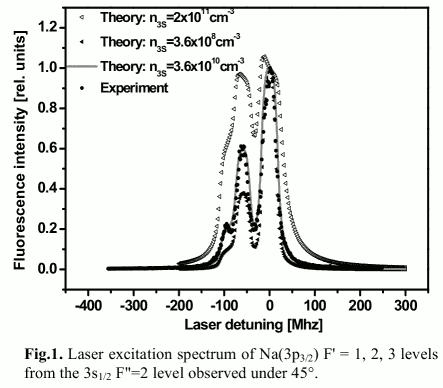Alkali resonance lines are long known to be affected by radiation trapping
in dense vapour media. In this report we demonstrate effects of
radiation trapping in a collimated supersonic beam of Na atoms. The
atomic beam was crossed by a laser at right angles, while laser
excitation spectrum of sodium D2-line
was measured at the angles of 45° and 90° with respect to the
atomic beam axis. The following unexpected features were observed in
the excitation spectrum.
 Firstly, itwas
found that the spectral lines are broader or narrower than the
expected Doppler width for observation at 45° and 90°,
respectively. Secondly, the spectral components corresponding to
excitation of different hyperfine levels exhibited intensity ratios
different from those expected from the theoretical line strengths.
Both findings are explained by a
combination of effects of optical pumping and radiation trapping
(RT). At low laser intensities, when nonlinear optical effects can be
neglected, RT can strongly affect lineshapes of the HFS components.
Comparison of the excitation spectrum measured at 45° with the
calculation for different atom densities in the beam is shown in
Fig.1. The simulation is based on the approach described in [1], and
it takes into account anisotropy of the velocity distribution of
atoms in the beam. The best agreement between the theory and the
experiment was observed for n
3S=3.6×1010
cm-3,
which is close to the density calculated from the saturated vapor
pressure and geometry of the beam. Sensitivity of RT to the density
of atoms in the beam can be exploited as a tool to measure atom
densities in atomic beams.
Firstly, itwas
found that the spectral lines are broader or narrower than the
expected Doppler width for observation at 45° and 90°,
respectively. Secondly, the spectral components corresponding to
excitation of different hyperfine levels exhibited intensity ratios
different from those expected from the theoretical line strengths.
Both findings are explained by a
combination of effects of optical pumping and radiation trapping
(RT). At low laser intensities, when nonlinear optical effects can be
neglected, RT can strongly affect lineshapes of the HFS components.
Comparison of the excitation spectrum measured at 45° with the
calculation for different atom densities in the beam is shown in
Fig.1. The simulation is based on the approach described in [1], and
it takes into account anisotropy of the velocity distribution of
atoms in the beam. The best agreement between the theory and the
experiment was observed for n
3S=3.6×1010
cm-3,
which is close to the density calculated from the saturated vapor
pressure and geometry of the beam. Sensitivity of RT to the density
of atoms in the beam can be exploited as a tool to measure atom
densities in atomic beams.